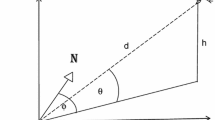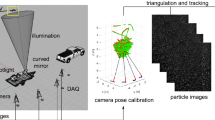Abstract
The study of wind–tree interaction represents a challenge in fluid dynamics partly because the three-dimensional tree crown and its branch structure are dynamically adapting to the mean and turbulent wind components. With the advent of infrared technologies these complex, three-dimensional, real time interactions between wind and the response of a tree can be assessed. The present work makes use of a Microsoft Kinect V2, which incorporates an infrared time-of-flight camera, to capture images containing point cloud data of a single garden tree in turbulent winds. The raw output from the sensor is used to translate three-dimensional information into mean crown positions and projected frontal canopy areas. This novel infrared time-of-flight sensor technique facilitates a better understanding of the behaviour of the tree crown against wind speed. Overall, less movement and larger crown areas are observed at lower wind speeds. As the wind speed increases, a general shrinkage in area, more swaying and a smoothing of the crown edges are noted. Correlations between the observed wind force exerted on the tree and the displacement of the crown centre as well as between the wind force and the projected frontal canopy area are determined. The displacement and the drag force are positively correlated for all wind speeds. The drag force and frontal canopy area are positively correlated at low wind speeds and negatively correlated at higher wind speeds with a bi-stable phase between. The infrared time-of-flight sensor has demonstrated its capacity to provide real-time three-dimensional scanning of trees in a wind testing facility providing new insights into the complex wind–tree interaction problem.
Graphic abstract











Similar content being viewed by others
References
Angelou N, Dellwik E, Mann J (2019) Wind load estimation on an open-grown European oak tree. Forestry 92(4):381–392
Barbacci A, Diener J, Hémon P, Adam B, Donès N, Reveret L, Moulia B (2014) A robust videogrametric method for the velocimetry of wind-induced motion in trees. Agric For Meteorol 184:220–229
Béland M, Widlowski JL, Fournier RA (2014) A model for deriving voxel-level tree leaf area density estimates from ground-based lidar. Environ Model Softw 51:184–189
Bunce A, Volina JC, Millera DR, Parenta J, Mark R (2019) Determinants of tree sway frequency in temperate deciduous forests of the northeast United States. Agric For Meteorol 266–267:87–96
Corti A, Giancola S, Mainetti G, Sala R (2016) A metrological characterization of the kinect v2 time-of-flight camera. Robot Auton Syst 75:584–594
Dellwik E, van der Laan MP, Angelou N, Mann J, Sogachev A (2019) Observed and modeled near-wake flow behind a solitary tree. Agric For Meteorol 265:78–87
Der Loughian C, Tadrist L, Allain JM, Diener J, Bruno M, de Langre E (2014) Measuring local and global vibration modes in model plants. Comptes Rendus Mécanique 342:1–7
Fürsattel P, Placht S, Balda M, Schaller C, Hofmann H, Maier A, Riess C (2015) A comparative error analysis of current time-of-flight sensors. IEEE Trans Comput Imaging 2(1):27–41
Hangan H (2014) The wind engineering energy and environment (WindEEE) dome at Western University, Canada. Wind Eng JAWE 39:350–351
James KR, Moore JR, Slater D, Dahle GA (2017) Tree biomechanics. CAB Rev 12(038):1–11
Kane BM, Smiley ET (2006) Drag coefficients and crown area estimation of red maple. Can J For Res 36(8):1951–1958
Manickathan L, Defraeye T, Allegrini J, Derome D (2018) Comparative study of flow field and drag coefficient of model and small natural trees in a wind tunnel. Urban For Urban Green 35:230–239
Mayhead G (1973) Some drag coefficients for British forest trees derived from wind tunnel studies. Agric Meteorol 12:123–130
Queck R, Bernhofer C (2010) Constructing wind profiles in forests from limited measurements of wind and vegetation structure. Agric For Meteorol 150(5):724–735
Rudnicki M, Mitchell SJ, Novak MD (2004) Wind tunnel measurements of crown streamlining and drag relationships for three conifer species. Can J For Res 34(3):666–676
Seggers R (2015) Bachelor Thesis—People tracking in outdoor environments. Evaluating the kinect 2 performance in different lighting conditions. Faculty of Science, University of Amsterdam
Sellier D, Fourcaud T (2005) A mechanical analysis of the relationship between free oscillations of Pinus pinaster Ait. saplings and their aerial architecture. J Exp Bot 56(416):1563–1573
Vogel S (1989) Drag and reconfiguration of broad leaves in high winds. J Exp Bot 40(8):941–948
Vollsinger S, Mitchell SJ, Byrne KE, Novak MD, Rudnicki M (2005) Wind tunnel measurements of crown streamlining and drag relationships for several hardwood species. Can J For Res 35(5):1238–1249
Wasenmuller O, Stricker D (2017) Computer vision—ACCV 2016 workshops: comparison of kinect v1 and v2 depth images in terms of accuracy and precision, vol 10117. Springer International Publishing, Berlin
Yang M, Défossez P, Danjon F, Fourcaud T (2014) Tree stability under wind: simulating uprooting with root breakage using a finite element method. Ann Bot 114(4):695–709
Author information
Authors and Affiliations
Corresponding author
Additional information
Publisher's Note
Springer Nature remains neutral with regard to jurisdictional claims in published maps and institutional affiliations.
Electronic supplementary material
Below is the link to the electronic supplementary material.
Supplementary file1 (AVI 4,57,415 kb)
Supplementary file2 (AVI 4,59,194 kb)
Supplementary file3 (AVI 4,62,251 kb)
Supplementary file4 (AVI 4,56,332 kb)
Rights and permissions
About this article
Cite this article
Enuş, M., Dellwik, E., Mann, J. et al. Three-dimensional measurements of tree crown movement using an infrared time-of-flight camera. Exp Fluids 61, 234 (2020). https://doi.org/10.1007/s00348-020-03053-y
Received:
Revised:
Accepted:
Published:
DOI: https://doi.org/10.1007/s00348-020-03053-y




